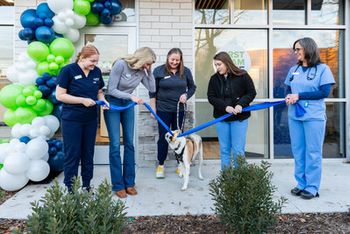
Six key lessons about building
This doctor spent nearly 15 years planning his addition and renovation. Along the way, he learned to expect pitfalls, use long-lasting materials, and dream big.
In 1989, Dr. Rex Bailey attended his first Veterinary Economics Hospital Design Conference, just four years after he graduated from the Purdue University School of Veterinary Medicine. During the next 15 years, he attended three more conferences, visited countless practices, and gathered as much information as possible to make the building process smooth.
"I learned a great deal from talking with others who'd built hospitals and from my own experiences—good and bad—during the building process," says Dr. Bailey. "I really think hearing people's stories and gathering as much advice as possible saves you pain in the end."
As a Merit Award winner in the 2005 Veterinary Economics Hospital Design Competition, Dr. Bailey clearly applied the lessons he learned to complete a successful renovation and addition to his practice. Today, he says Michigan City Animal Hospital in Michigan City, Ind., is the hospital he knew it could be. And he walked away from the experience with six key lessons about making a veterinary building project work.
1. Do your homework
"It's never too early to start dreaming about what you want," says Dr. Bailey. "Start a notebook to keep track of design ideas and features that you want to include in your practice. I've kept a notebook like this since 1989."
The spacious waiting area features clerestory windows near the 25-foot-high ceiling, an airlock vestibule, and built-in benches arranged to give waiting clients and their pets some privacy. A client transaction counter and discharge area lead clients to the exit for a smooth traffic flow.
Then visit as many veterinary hospitals as possible, both new and old, Dr. Bailey advises. "Write down what you'd change about each hospital and what the veterinarians who work there say they'd change and why," he says. "I found it extremely beneficial to talk with associates as well as practice owners; in some cases, the owner is more removed from daily practice. I also asked staff members which areas were hard to clean and what they would do differently if they had built the practice."
Attending four Hospital Design Conferences gave Dr. Bailey a working knowledge of the building process and a better understanding of the materials used and the touches that make a hospital stand out. "I learned a lot about the pros and cons of different materials, and hearing everyone's stories really helped me to set my priorities," he says.
You should also research your building team, Dr. Bailey says. For example, when he found a builder he liked, Dr. Bailey visited several hospitals that he'd built. "I asked lots of questions and learned what the owners wished the builder had done differently. Overall the builder got a good report, which was important to me. I wanted to feel very comfortable with the person I put in charge of building my facility." His choice, a design-build company, provided his project with consistency and cost containment, he says.
2. Play up your exam rooms
"A lot of doctors skimp on the number of exam rooms or the features they include," says Dr. Bailey. "But you make your money in the exam rooms, so I think they need to be big and comfortable and conducive to growing your business."
Dr. Bailey's practice includes seven exam rooms, shared between three full-time doctors. Five of the exam rooms measure 11-by-10 feet, and two measure 14-by-11 feet, which is larger than average, he says. "Every exam room is set up so the doctor faces the client while examining the pet," he says. "And we arranged the rooms so a distraught or grieving client can leave the hospital without passing through the reception area."
Hospital Design
3. Spring for high-end materials and equipment
Two-toned porcelain tile sealed with epoxy covers the floor and six-inches up the walls in the waiting area and retail space. The exam rooms feature LCD monitors to play client-education DVDs and to show clients what the doctors or technicians are viewing in the microscope; and during surgery, ultrasonography, or endoscopy. The treatment islands are stainless steel. And this list of high-quality touches goes on and on, which was Dr. Bailey's plan from the beginning.
"I put in any material I could afford that would keep the practice looking new for 20 years, because that's how long it'll take me to pay for the hospital," he says. "For example, I asked architects at the Hospital Design Conference what flooring they would use if expense wasn't an issue, and they said porcelain sealed with epoxy. So I shopped around and found a pretty good price on it. I figure it's better to use a long-lasting material than to re-do the floors in a few years because I chose a less-expensive, less-durable product."
Dr. Bailey's advice: Identify your first-, second-, and third-choice materials, then shop around for the best prices. "You may find a better price than you expect, and I think the added expense is worth it in the end if the materials last."
A dramatic new hospital entrance and walkway help guide clients and re-direct traffic from the former entryway. The architect used a stair-step design to maximize the site and blend the old and the new buildings.
4. Expect problems, pitfalls, and delays
Michigan City Animal Hospital had been at the same location since 1949, with only three owners during that time. The advantages of staying at the same address and adding on and remodeling far outweighed the benefits of building a new facility someplace else, Dr. Bailey says. But he says he quickly learned that staying also brought a unique set of problems.
For starters, the current facility used a well and septic system for water, but with the addition Dr. Bailey learned he'd need to spend $6,000 to run pipe under a four-lane highway to hook up to the city water supply. Next, he had to shell out about $30,000 for septic hookup, tanks, pumps, and installation.
The unexpected costs didn't stop there. A required soil test showed no reason for concern, but as construction workers began to dig, they turned up such oddities as concrete, car dashboards, and telephone poles. "We pulled everyone off the project until we could sort out the problem and figure out what to do," he says. "We ended up paying an extra $56,000 to overdig, dewater, and fill the site with crushed concrete for a base foundation before we even started construction." Dr. Bailey says the financial setback meant he needed to refinance and change the scope of the project mid-stream—which led to an additional $20,000 in closing costs.
The lesson: Delays, setbacks, and additional costs are unavoidable. "Just do what you can to prepare," Dr. Bailey says. "Set clear priorities for the project and communicate regularly with your builder to minimize changes along the way—then go with the flow and don't worry too much about what you can't control."
All of the countertops, treatment islands, and workstations are built a few inches higher than normal to decrease strain while standing at the counters to work or write.
5. Add your own touch
Dr. Bailey considers landscaping a hobby. And that's a good thing, because he ended up adjusting for some of the cost overruns by landscaping the practice himself, with help from his wife, four children, and parents. "My family and I put down 20,000 yards of sod and planted 500 plants and flowering bushes. We chose plants with staggered bloom times, so something will be flowering all the time. Doing the landscaping ourselves was a lot of work, but the effort really improved the exterior appearance of the practice."
Dr. Bailey also planned his hospital entryway with plants in mind. "I wanted something flowering in our waiting room year-round, so I made sure the entry would provide enough natural light," he says. Another personal touch: A friend of Dr. Bailey's painted a 12-by-15-foot mural on the rear wall of the waiting room, facing the entry. Artist Neil Kienitz spent weeks painting the mural, even painting during an open house and in front of clients during the first weeks the hospital was open.
6. Enjoy!
"Every building project brings work and stress, but preparation smoothes out some of the bumps," says Dr. Bailey. "I love the results we achieved with our project and think we've created a clean, comfortable, and educational experience for our clients. That makes all the headaches we suffered worthwhile."
"Here's my best advice," says Dr. Bailey. "Dream big and work hard. It'll all be worth it in the end."
Sarah A. Moser is a freelance writer in Olathe, Kan. Please send questions to
Newsletter
From exam room tips to practice management insights, get trusted veterinary news delivered straight to your inbox—subscribe to dvm360.






